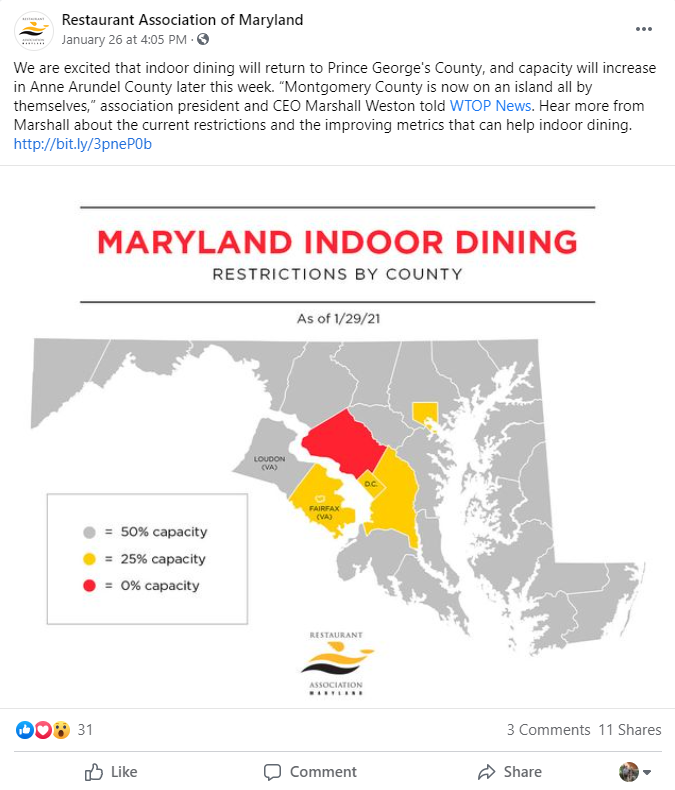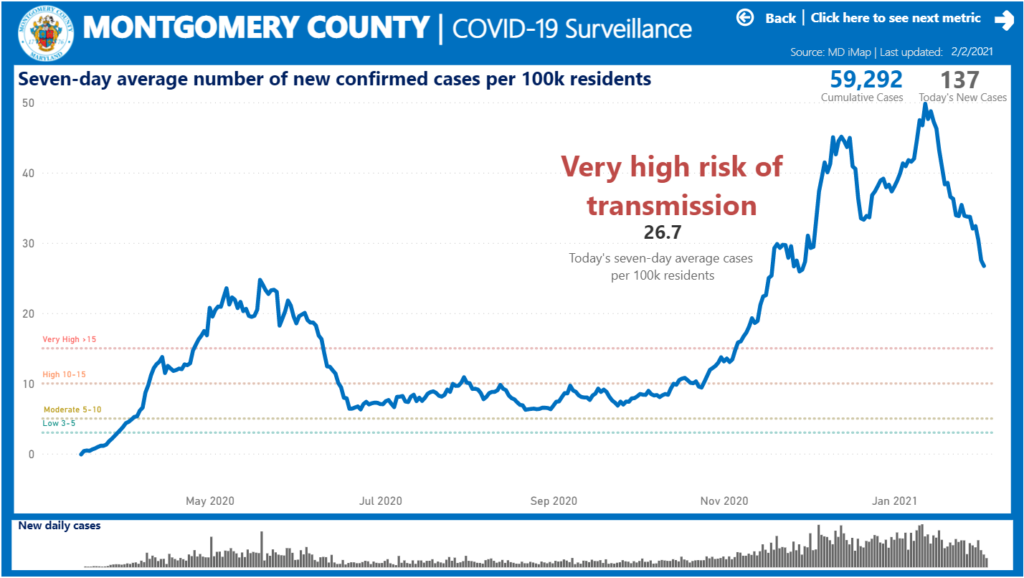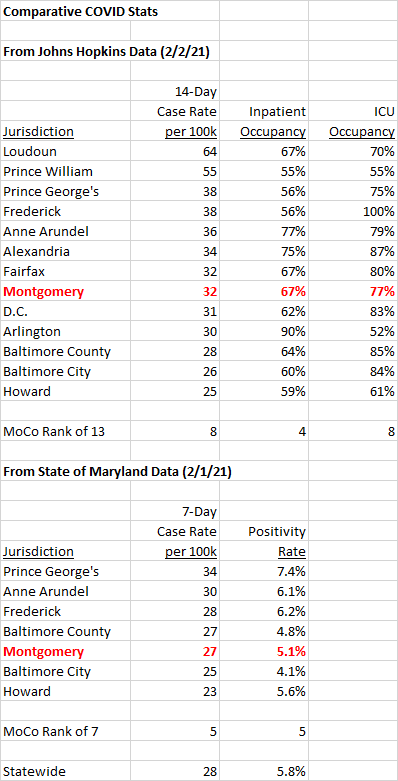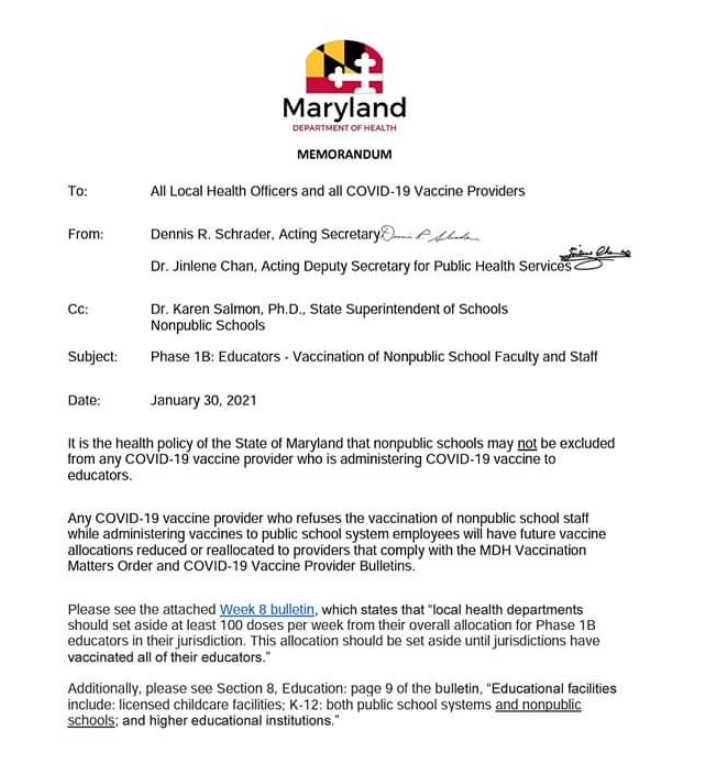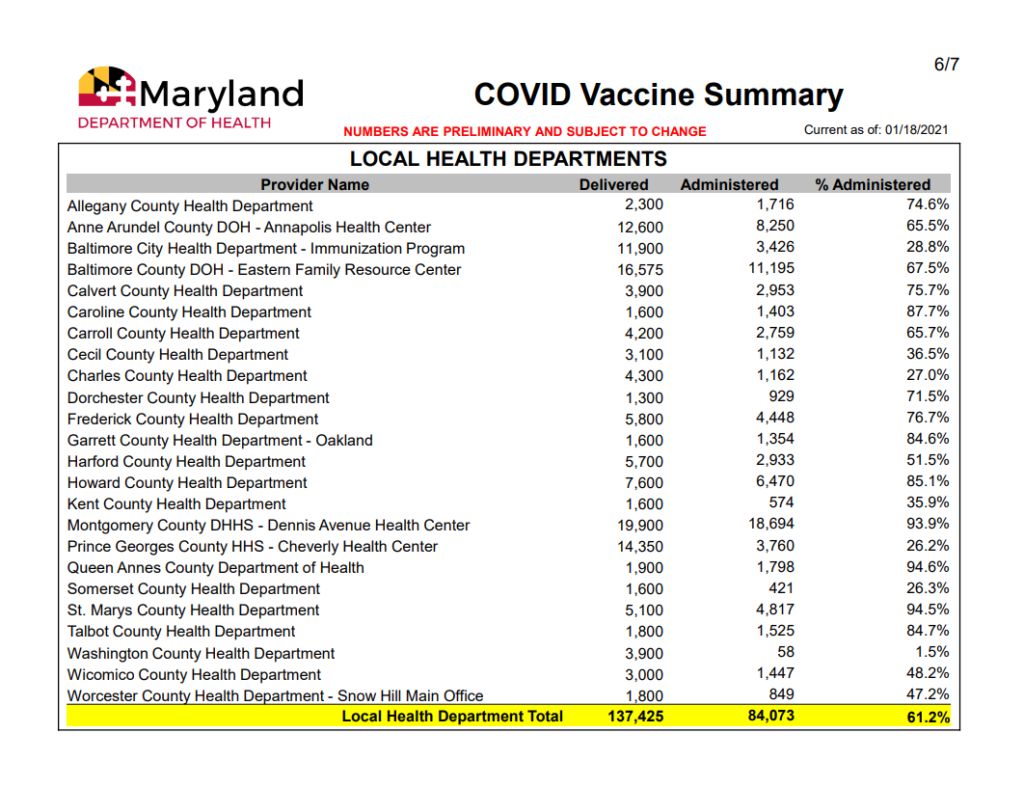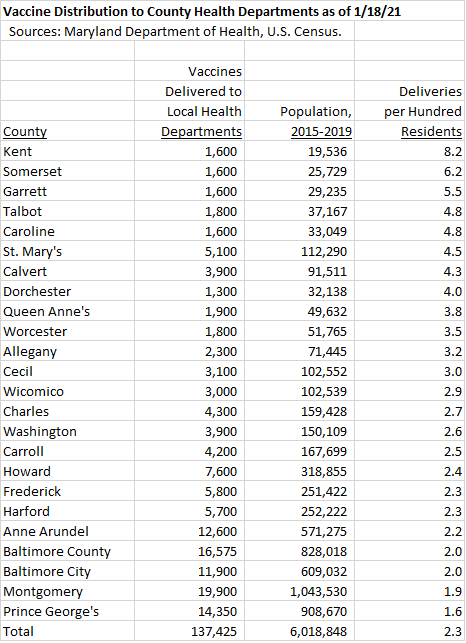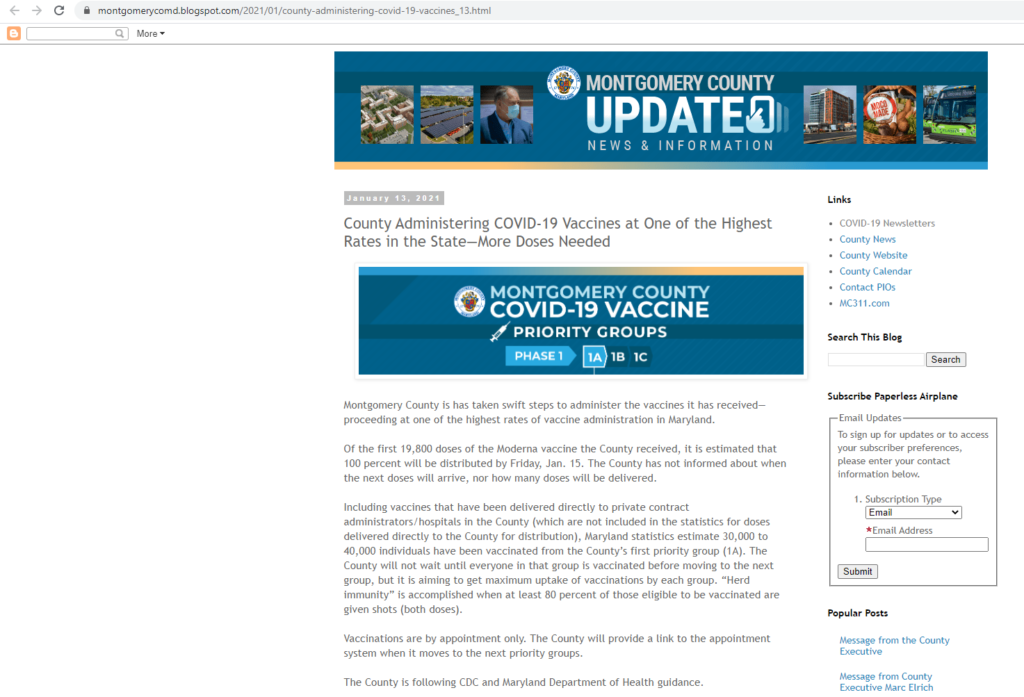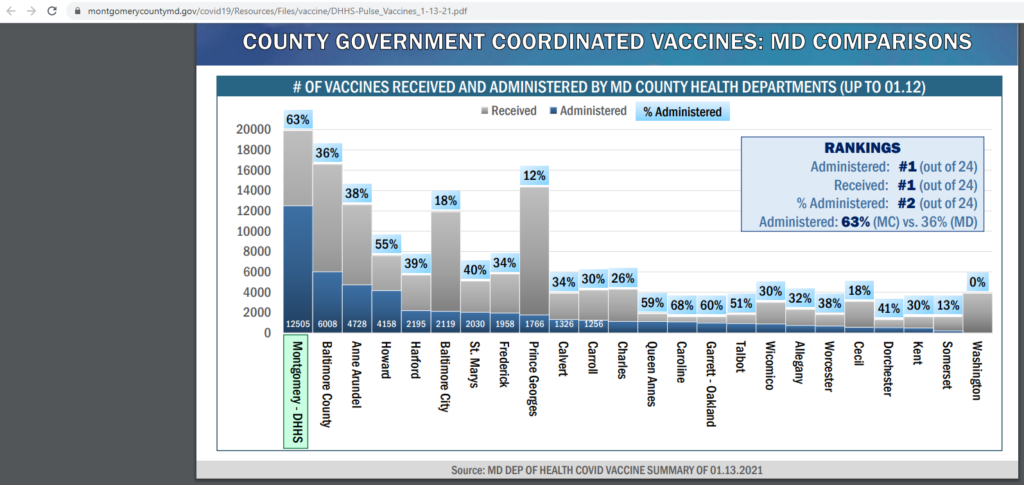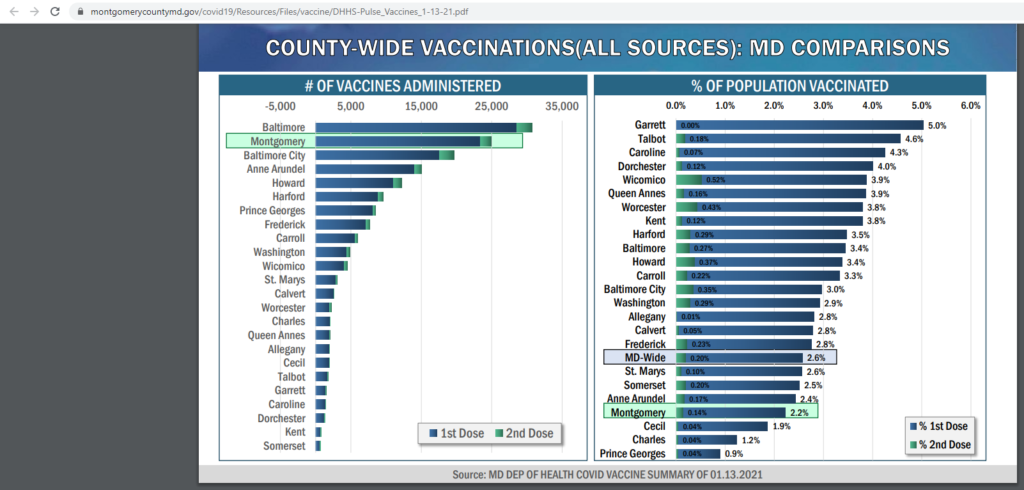By Adam Pagnucco.
Voicing concerns that MoCo is not receiving its fair share of vaccines from the state, the county’s state legislators have written to Governor Larry Hogan asking for more doses. The letter was signed by all 8 state senators and all 24 delegates who represent MoCo in Annapolis. It is reprinted below.
*****
February 8, 2021
Governor Lawrence J. Hogan, Jr.
100 State Circle
Annapolis, MD 21401
Dennis Schrader, Acting Secretary
Maryland Department of Health
201 West Preston St.
Baltimore, Maryland 21201
Rona Kramer, Secretary
Maryland Department of Aging
301 West Preston St., Suite 1007
Baltimore, MD 21201
Dear Governor Hogan, Acting Secretary Schrader, and Secretary Kramer:
We are writing to express significant concern that the DC Metro region is falling behind the rest of the state in terms of vaccination. We must address this immediately before the disparity becomes worse. We appreciate the work you are doing, and know there are many competing interests to balance. Although there are many concerns that need to be addressed at the statewide level—such as the volume and complexity of registration options—the concerns expressed here are of particular concern to Montgomery County.
As of February 8th, the statewide rate of vaccination is 9.0%. Montgomery County is nearly a full percentage behind the state average, at 8.2%. Prince George’s County is at only 4.1%. Baltimore County has 10.5% of their population vaccinated, and some rural counties have vaccination rates of more than 14%. This is especially concerning because the DC Metro region leads the state in COVID infections and deaths.
In order to address this disparity we request that the state:
1) Send a larger share of vaccines to hospitals and Health Departments in the areas of the state that have the greatest COVID spread and highest COVID death rates.
Three of the top five zip codes for COVID case counts in the state are in Montgomery County. A fourth is in Prince George’s County. Montgomery County has the most COVID deaths in the state, followed closely by our neighbor Prince George’s. These numbers should be a part of the basis for allocation. The fact is more Marylanders are infected and dying in the DC Metro area.
2) Send a larger share of vaccines to the hospitals and health departments in jurisdictions where more people are eligible for the vaccine.
In addition to lagging in percentage vaccinated, Montgomery County is also leading in the length of our waitlist and competition for the vaccine because Montgomery County has among the highest percentage of people eligible for the vaccine. That includes Montgomery County’s disproportionate share of essential workers who live in the County and outside of the County, as well as the large share of Montgomery County residents over the age of 65. But those on-the-ground realities are not addressed by the state’s reasonable sounding but flawed per capita allocation strategy that does not take into account differences in percentage of people eligible per priority group.
One reason Montgomery County is lagging the state is that the vast majority of vaccines to date have gone to protect our essential workers. Between one third and one half of our workforce lives outside of Montgomery County. Among the Montgomery County hospital employees offered vaccines, available data indicates nearly half live in other jurisdictions within Maryland or DC. A large percentage of our police, fire, and EMS also live outside of Montgomery County, which is reflected in the fact that Montgomery County is ranked 20 out of 24 jurisdictions in Maryland for the percentage of population vaccinated. While we are fully committed to vaccinating our essential workforce, we need a vaccine allocation that acknowledges significant numbers of the vaccines administered by our hospitals and County Health Department are going to residents of other jurisdictions.
According to the State Plan on Aging, people 85+ make up 1.7% of Maryland’s population. But in Montgomery County they are 2.1% of the population, which equates to about 22,000 people. The County is above the state average for 75+ and 65+ as well. We ask the Administration to update its current allocation formula to reflect Montgomery County’s extremely large health care workforce and senior population. Both of these factors have combined to make the Montgomery County waitlist for vaccine access include over 250,000 people, which as an online preregistration is an underestimate for the total number of people eligible in priority groups 1A, 1B, and 1C. While hospitals, the Health Department, and pharmacies have vaccinated about 20,000 residents over age 75, there are still 53,000 seniors in this age range awaiting vaccination. Based on the allocation of 11,000 doses received last week, it will take 4-5 weeks for Montgomery County to vaccinate all of our 75+ population. We understand and appreciate the difficulty of balancing priorities and needs with a limited supply of vaccines. However, given that weekly bulletins from Maryland Department of Health advise vaccinators to prioritize the population over age 75, we urge you to help us make this possible by allocating more vaccines to jurisdictions with insufficient supply for a given priority phase.
3) As soon as possible, add a mass vaccination site in Montgomery County.
While we appreciate the mass vaccination locations being opened in Prince George’s County and Baltimore City and understand the current limits in our state’s supply from the federal government, there is also a desperate need for a mass vaccination site in Montgomery County. It is our understanding that the County Government has offered the County Fairgrounds as a possible site. If a mass vaccination site cannot be established in Montgomery County as sites expand across the state, we request the doses that would go to such a site be sent to the Montgomery County Department of Health for more equitable distribution.
We believe addressing the above mentioned disparities are urgent because our delegation members are hearing daily from people in their eighties who still have not been able to secure vaccination appointments through any of the currently available options. Of course, long waitlists across the County of seniors and essential workers also makes it harder for smaller eligible groups to get vaccinated, like the immunocompromised and people with developmental disabilities. If changes are not made to the state allocations, Montgomery County’s vulnerable seniors and our essential workers will be waiting much longer for vaccine access than our neighbors in other parts of Maryland. While a simple per capita allocation was efficient in the early weeks of the rollout, it has become clear through the data that this approach is not equitable or effective, and leaves too many of our most vulnerable Maryland residents unprotected. It’s now time to have an updated formula with these factors in mind to ensure the DC Metro region does not fall further behind. Independent living facilities have also been a major concern given the difficulties with the Federal Long-Term Care Partnership. We’re particularly appreciative of Secretary Kramer and the Administration for making this a top priority and hope we can quickly begin to vaccinate some of the most high risk residences.
Thank you for your attention in this matter. We also look forward to discussing this further when the Maryland Department of Health joins the Montgomery County Delegation at our February 12th meeting.
Sincerely,
Senator Craig Zucker
Senator Susan Lee
Senator Brian Feldman
Senator Cheryl Kagan
Senator Nancy King
Senator Ben Kramer
Senator Will Smith
Senator Jeff Waldstreicher
Delegate Marc Korman
Delegate Al Carr
Delegate Gabriel Acevero
Delegate Kumar Barve
Delegate Lorig Charkoudian
Delegate Charlotte Crutchfield
Delegate Bonnie Cullison
Delegate Kathleen Dumais
Delegate David Fraser-Hidalgo
Delegate Jim Gilchrist
Delegate Anne Kaiser
Delegate Ariana Kelly
Delegate Lesley Lopez
Delegate Sara Love
Delegate Eric Luedtke
Delegate David Moon
Delegate Julie Palakovich Carr
Delegate Lily Qi
Delegate Pam Queen
Delegate Kirill Reznik
Delegate Emily Shetty
Delegate Jared Solomon
Delegate Vaughn Stewart
Delegate Jheanelle Wilkins

